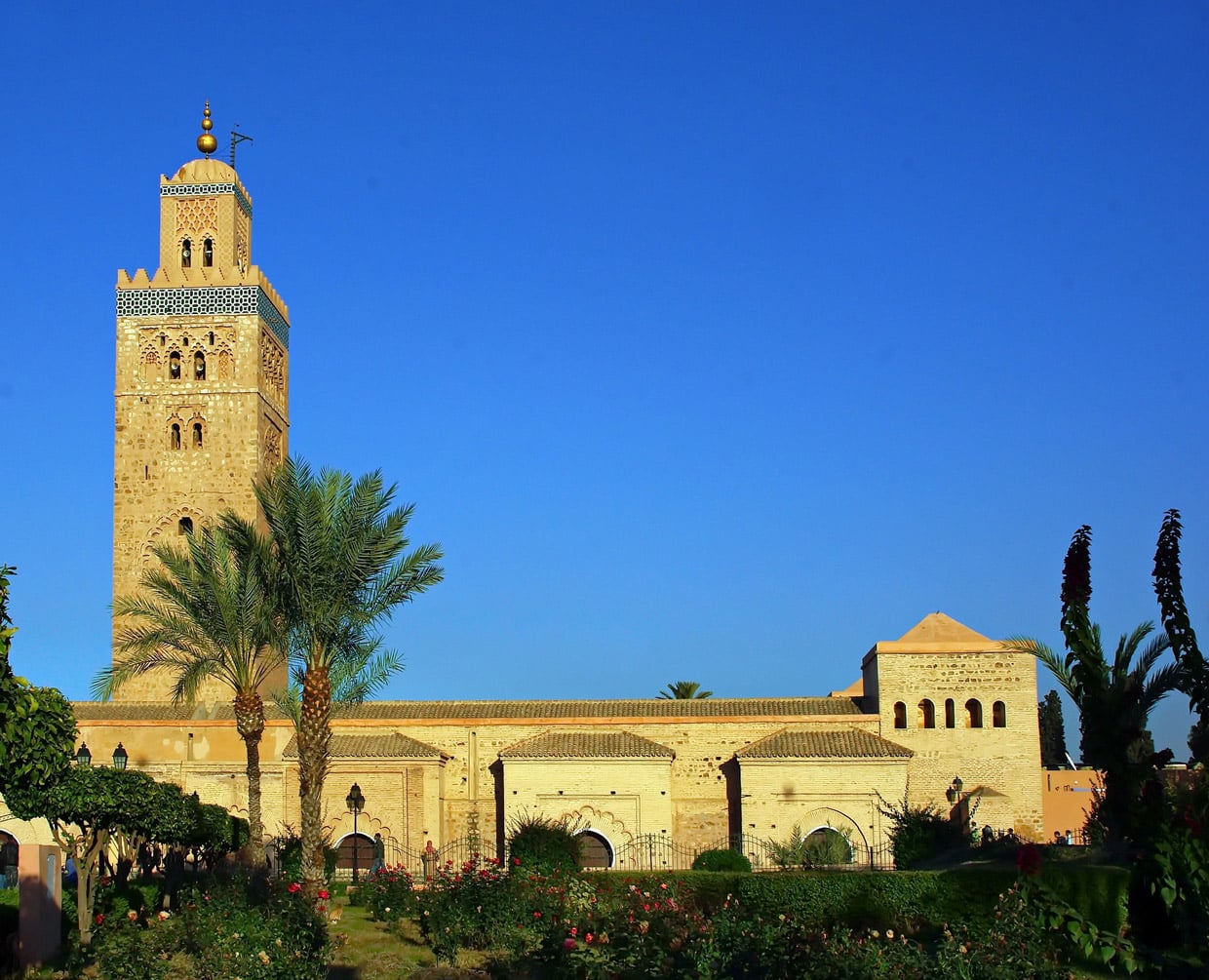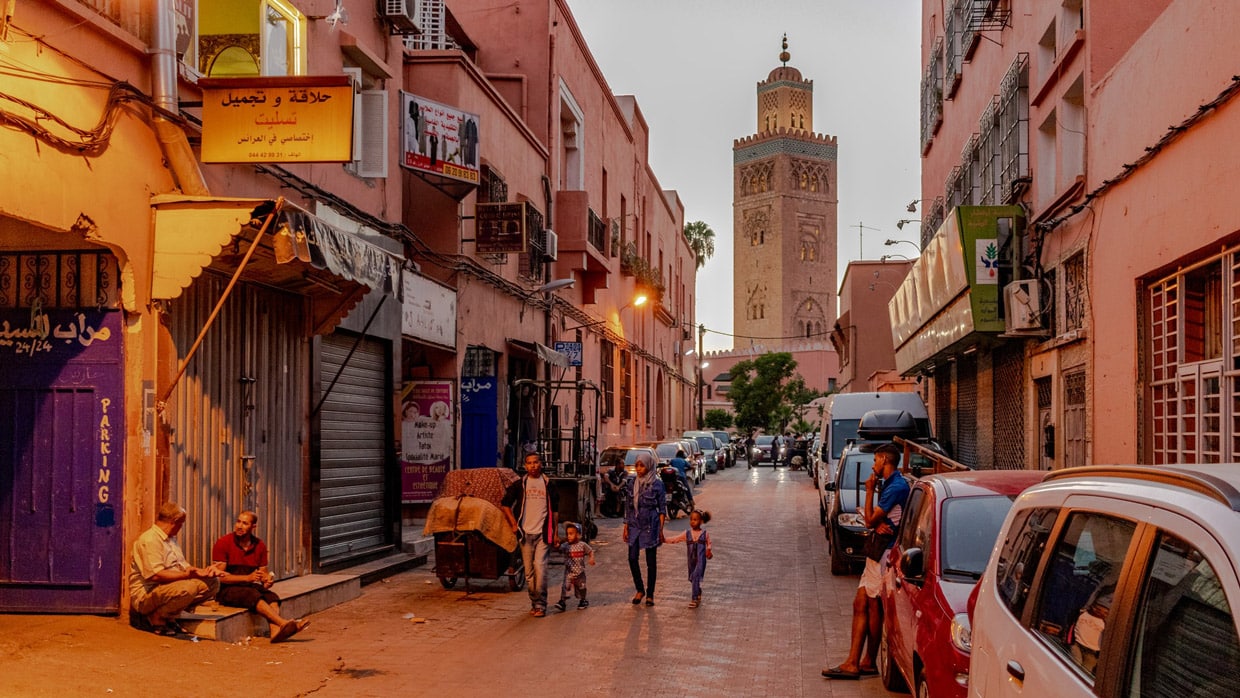Imagine a caravan running over Morocco many years prior and face a tall minaret. Its supplication time and hot, calm desert air permit the monotonous azan of the muezzin to float out to meet them. Such sights and sounds have welcomed passengers as they approached Morocco for over 700 years.
Sitting in the focal point of the city is the Koutoubia Mosque and minaret. It is situated in the southwest medina quarter of Morocco, close to the well-known public spot of Jemaa el-Fna, and is flanked by a huge park with lovely flowers. Let’s get a close glance at this ancient mosque.
Geography
The mosque is situated around 200 meters (660 ft) west of the city’s Jemaa El Fna souq, a conspicuous commercial center that has existed since the city’s foundation. It is arranged on Avenue Mohammed V. The organization of streets and unbanning was at the same time as the mosque was built by French engineers.
Toward the west and south of the mosque is an eminent rose nursery, and across the road is the little tomb of the Almoravid emir Yusuf ibn Tashfin, one of the extraordinary developers of Morocco, comprising a basic crenelated structure. In the mosque’s esplanade, the remnants of the primary Koutoubia Mosque can be seen. A piece of the border of the Ksar al-Hajjar was likewise uncovered on the northern side of the first mosque.

History of Koutoubia Mosque
At the point when the Almoravid administered Morocco, a mosque had been based upon this equivalent site. When the Almohads caught the zone, in any case, they obliterated a significant part of the city alongside the mosque. Another mosque was raised on the site in the Almohad style, and parts of the present-day mosque do trace back to the period of king Abd el-Moumen.
An issue with the direction of the petition specialty to Mecca brought about a subsequent mosque being worked to address this mistake correctly. This Moorish mosque is rumored to be a zenith of Almohad craftsmanship. Spanish and Moorish guidance can be found looking like the curves, domes, and painted roofs. Another reality novel to this mosque is it was worked during the rule of one ruler. Other similar mosques took many years to be finished.
The First Koutoubia Mosque
The principal establishment and development of the Koutoubia Mosque were in 1147. Adjoined to the dividers of the previous Almoravid kasbah, the mosque may have additionally been based on top of a portion of the previous Almoravid royal residence’s extensions and possibly over an imperial burial ground or catacomb.
The mosque was likely associated with the contiguous imperial castle using a private way (Sabat) which permitted the Almohad caliph to enter it straightforwardly from his royal residence without going through the public doors. This section probably went through the imam’s chamber behind the southeastern qibla divider and, accordingly, may have vanished when the subsequent mosque was worked over this area.
Current archeological uncovering had asserted the presence in the principal Koutoubia Mosque of a nearby fantastic part that allowed the wooden Maqsura to climb from a direct in the ground obviously without any other individual and subsequently pull out along these lines when the caliph left. Maqsura is a screen that isolates the caliph and his company from the remainder of the group during petitions.
In this way, the new Almohad mosque was saturated with extraordinary political and strict imagery, being firmly connected with the decision line and made unobtrusive references to the antiquated Umayyad Caliph, whose incredible mosque was a model for a lot of ensuing Moroccan and Moorish designers. It is obscure if the main Koutoubia Mosque had a minaret.
However, a few antiquarians have recommended that a previous stronghold of the Almoravid kasbah on the mosque’s northeastern corner may have been changed over into the mosque’s first minaret. Its remaining parts may have been obvious even as late as the start of the nineteenth century.
It is equivocal when precisely the primary Koutoubia Mosque vanished; however, its design is notable on account of current unearthing beginning in 1923. On the north side of the mosque still, there are some remaining parts of the mosque, like the Mihrab or Qibla wall layout.
The Second Koutoubia Mosque
Abd al-Mu’min ordered to build a subsequent mosque straightforwardly appended toward the main mosque’s southeastern (qibla) side. The explanations behind this unordinary choice are as yet not completely comprehended. The most famous chronicled story affirms that Abd al-Mu’min found, perhaps during its development, that the underlying mosque was skewed with the qibla (apparently as per Almohad standards).
The subsequent mosque is to be sure adjusted marginally further toward the south. Other potential inspirations for the development of the mosque may have been to oblige a developing populace, to twofold the structure’s size to make it more noteworthy, or even as a pardon to make one of the mosques select to the decision elites while the difference was utilized by everybody.
The development dates of the subsequent mosque are additionally not immovably settled. One verifiable account claims that development started on the subsequent mosque in May 1158 and was finished with the introduction of the main Friday petitions in September of that very year. Notwithstanding, this development period appears to be unrealistically short and all things considered, development either started before May 1158 or (maybe more probable) proceeded after September 1158. The popular minaret of the mosque, which is noticeable today, is additionally not definitively dated.
The second Koutoubia Mosque was constructed practically indistinguishable from the first except for its changed direction. The format, engineering plans, measurements, and materials utilized for development were practical all the same. The solitary design contrasts are in a couple of subtleties and in the way that the subsequent mosque was somewhat more extensive than the first. The mosque’s floor plan is also somewhat irregular because its northern divider is as yet the old south mass of the principal mosque, which is at a marginally unique point from the subsequent mosque (because of the diverse qibla direction, as clarified previously).
Today’s Koutoubia Mosque
The mosque and its minaret were reestablished toward the finish of the 1990s.In 2016 the mosque was fitted with sun-oriented boards, sunlight-based water warmers, and LED lights as a feature of a push to update mosques more reliant on sustainable, environmentally friendly power energy.

Architecture
Compositional subtleties of the main mosque and the subsequent mosque are practically indistinguishable except the orientation. Hence, what is valid for one remains constant for the other. The primary mosque is presently just obvious as the remaining archeological parts. The mosque is a trademark Almohad plan, and its different components take after those of numerous different mosques from a similar period. The mosque’s floor plan is a somewhat unpredictable quadrilateral because of the way that its northern divider compares to the previous southern mass of the principal mosque.
Exterior
The mosque has various gardens. At the top of some roofs, there are large spotlights. The divider on the northern side of the principal mosque adjoined the old Almoravid post divider. There are eight passageways to the mosque: four on the west and east sides. The eastern side faces the road where book shops were found, subsequently the name “Bookseller Mosque.”
There is a private passageway for the imam on the south side of the mosque, prompting an entryway on the left half of the mihrab. Verifiably, the primary Koutoubia Mosque likewise had a private passageway close to the mihrab, which was utilized by the ruler to enter straightforwardly into the Maqsura.

Interior
Courtyard (Sahn)
The rectangular Courtyard or Sahn is in the northern piece of the mosque. It is 45 meters (148 ft) wide, similar width to the nine focal naves, and 23 meters (75 ft) long or profound. There is a bathing wellspring at the focal point of the yard. These days trees are additionally planted in a lattice design all through the patio. The beautification is usually restricted to the curves running along the edges of the patio, with a portion of the curves are featured with a Multifoil arch forming a cut around them.
Prayer Hall
The inside petition lobby is a hypostyle corridor with more than 100 columns that helplines horseshoe curves that partition the lobby into 17 equal naves or paths that run opposite toward the southern divider, or generally north to south. The columns and curves are made of blocks shrouded in white plaster.
The nine naves in the center relate to the width of the patio toward the north and run the length of six curves. The four furthest naves run ceaselessly along the east and west sides of the yard. The naves are completely covered by Moroccan wood-outline roofs within an inclined green-tiled rooftop outwardly.
Minaret
The minaret is planned in Almohad style and was developed in rubble workmanship utilizing sandstone. It was generally covered with Morocco pink mortar, yet during the 1990s, specialists selected to uncover the first stonework and eliminated the mortar. The minaret tower is 77 meters (253 ft) in height. The minaret is noticeable from a distance of 29 kilometers (18 mi). Its unmistakable quality makes it a milestone construction of Morocco, which is higher than any near construction or palm trees.
Koutoubia Mosque is the largest mosque in Morocco. No one can’t ignore the effective rule of this mosque in Morocco design and even the whole Islamic art world. Shockingly, non-Muslims are not allowed to enter the mosque, yet you can go up near the structure and investigate the patio, gardens and close by a burial ground. There are many local shops near each entrance that are completely worthy of visiting or even buying a beautiful Moroccan handicraft from local people.





